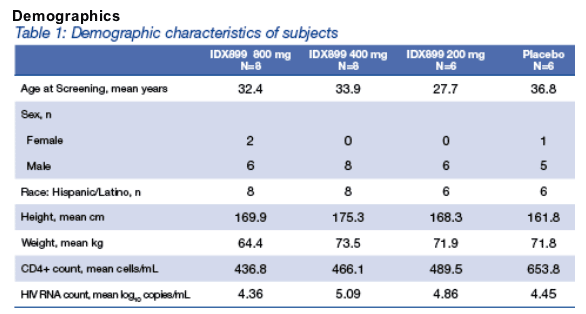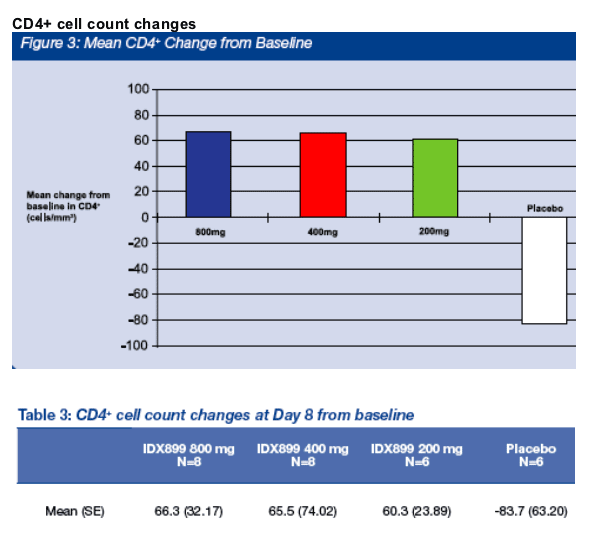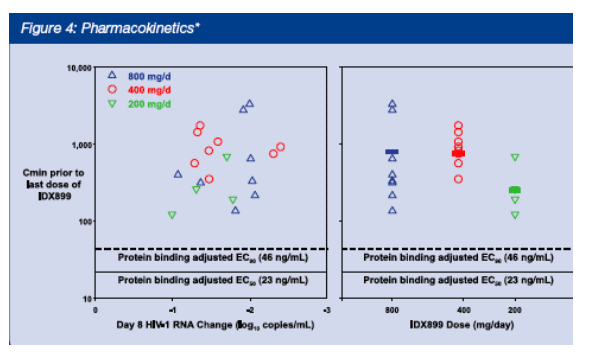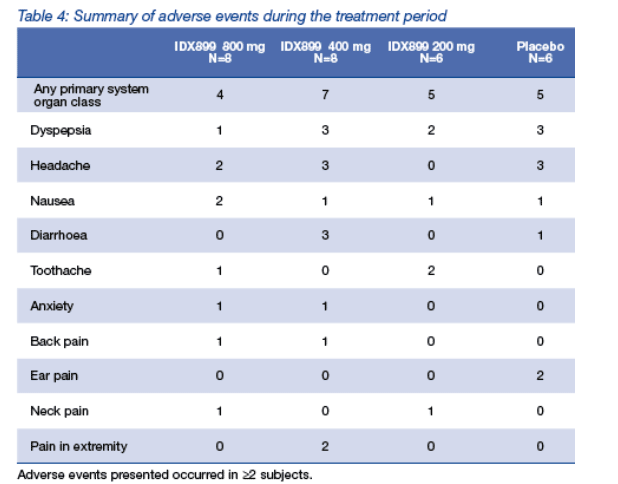 |
 |
 |
| |
Antiviral Activity, Safety and Pharmacokinetics of IDX899, a Novel HIV-1 NNRTI with High Barrier to Resistance, in Treatment-Na´ve HIV-1-Infected Subjects
|
| |
| |
Reported by Jules Levin
17th HIV Drug Resistance Workshop
June 10-14, 2008
Sitges, Spain
R Murphy1, C Zala2, XJ Zhou3, K Pietropaolo3, J Sullivan-Bolyai3, B Belanger3, and D Mayers3
1Northwestern University Feinberg School of Medicine, Chicago, IL, USA; 2ACLIRES Argentina, Buenos Aires,
Argentina; and 3Idenix Pharmaceuticals, Inc., Cambridge, MA, USA
AUTHOR CONCLUSIONS
· IDX899 was generally safe and well tolerated at all doses in HIV-1-infected subjects.
· IDX899 demonstrated potent antiviral activity, 1.8 log10 using Roche Amplicor 1.5 assay, in HIV-1-infected subjects at all tested doses.
· No clear PK/PD relationship was demonstrated, likely due to drug trough levels being well above the EC90 of IDX899 against wild-type viruses.
· The Roche COBAS TaqMan HIV RNA assay frequently underestimated viral load and viral load reduction compared to the COBAS Amplicor 1.5 assay.
· The protocol was amended to add a 100 mg cohort which has been initiated.
Background
· IDX899 is a potent and selective second generation non-nucleoside reverse transcriptase inhibitor (NNRTI) of HIV-1. 1,2,3,4
· Previous in vitro data indicate a high barrier to resistance and a good overall resistance profile. 2,4
· IDX899 pharmacokinetics support once-daily oral dosing. 5
· Administered orally, IDX899 appears to be safe and well tolerated at single doses up to 1200 mg and multiple doses up to 800 mg once daily (QD) over 7 days in healthy volunteers. 5
Objectives
· To investigate safety and tolerability of IDX899 in treatment-na´ve HIV-1 infected subjects.
· To evaluate the antiretroviral activity and pharmacokinetics of IDX899 after QD oral dosing over 7 days treatment.
Methods
Study design
· Phase I/IIa, double-blind randomized, sequential cohort, single center study in Buenos Aires, Argentina.
· Treatment-na´ve HIV-1-infected subjects were randomized 8:2 to receive either IDX899 or placebo, respectively, as a single agent for 7 days.
· IDX899 doses of 800 mg, 400 mg and 200 mg were evaluated.
· Eligible subjects were placed on Kaletra monotherapy for 28 days or initiated HAART following the last IDX899 dose.
Subjects
· Male or female of non-childbearing potential, 21-65 years old, with plasma HIV-1 RNA ≥5,000 copies/mL, CD4+ count ≥200 cells/mm3 treatment-na´ve patients were enrolled.
· Subjects' viruses had no pre-existing NNRTI drug resistance based on genotypic analysis at screening.
· Subjects with acute HAV infection, chronic HBV or active HCV were excluded. Sampling and analysis
· Efficacy measurements included changes in HIV-1 RNA by Roche COBAS TaqMan (LLOD= 48 copies/mL) and COBAS Amplicor 1.5 assays (LLOD = 50 copies/mL), and CD4+ T-lymphocytes cell counts.
· Intensive PK sampling was performed over 24 h after dosing on Days 1 and 7 with trough samples obtained daily. Plasma concentrations of IDX899 were analyzed using a validated LC/MS/MS methodology.
Statistical methods
· At the conclusion of each cohort, data analyses were performed on unblended data.
· HIV RNA changes from baseline are summarized using data as-observed. Means and standard errors of means are presented.
· The assessment of IDX899 treatment-emergent adverse events and laboratory abnormalities considered the study on-treatment period, i.e. Day 1 to Day 8.
Safety
· Safety and tolerability measurements included laboratory evaluations, physical examination, vital signs, 12-lead ECGs and AE assessments.
Results
· Patients in the 800 mg, 400 mg and 200 mg cohorts have completed the study.
· As of 06/06/08, 8 of 10 patients in the 200 mg cohort have HIV viral load completed. Complete data set will be included in the oral presentation.

· The Roche COBAS TaqMan assay appears to underestimate the viral load compared to the COBAS Amplicor 1.5 assay in HIV-1-infected patients from Argentina.
· Similar under-estimation of HIV viral load was described by Damond et al. 6

· Mean CD4+ cell count increased after 8 days in all IDX899-exposed cohorts.
· Mean CD4+ cell count decreased in the placebo group.
Pharmacokinetics

· No clear PK/PD relationship was observed.
· All three doses achieved trough drug levels exceeding the protein binding adjusted EC50 by >10-40 fold (individual range 5-140 fold).
Resistance
· All sequences from the 8 subjects in the 800 mg cohort were from Clade B.
· No selection of RT resistance mutations was observed in the 800 mg cohort, sequencing of additional cohorts is in progress.
Safety

· There were no treatment discontinuations, treatment-emergent SAEs or dose-limiting toxicities reported.
· No grade 3 or 4 laboratory abnormalities were observed during the treatment period.
· No discernable patterns in AE or laboratory abnormalities were observed.
References
1. Richman DD, Dousson CB, Storer R, et al (2007). 14th Conference on Retroviruses and Opportunistic Infections (CROI), Los Angeles, USA.
2. Jakubik J, Seifer M, Gray L, et al (2007). Antiviral Therapy;12:S32.
3. Idenix Pharmaceuticals, February 6th, 2008, press release.
4. Richman DD, Jakubik J, Chapron C, et al (2008). 15th Conference on Retroviruses and Opportunistic Infections (CROI), Boston, USA.
5. Mayers D, Hard M, Damphousse D, et al (2008). 15th Conference on Retroviruses and Opportunistic Infections (CROI), Boston, USA.
6. Damond F, Roquebert B, BÚnard A, et al (2007). J. Clin. Microbiol; 45:3436-3438.
|
| |
|
 |
 |
|
|